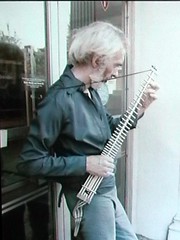brutus wrote:Is it anything like the Chapman Stick? (i think thats what its called)
Gittler guitar
From Wikipedia, the free encyclopedia
Jump to: navigation, search
Gittler stainless steel guitar
A Gittler Guitar is an experimental designed guitar created by Allan Gittler (1928–2003). Gittler realized that sentimental design references to acoustic guitars are unnecessary in an electronically amplified guitar, and designed his instrument with the objective of reducing the electric guitar to the most minimal functional form possible. He made 60 guitars in New York in the mid 1970s to early 1980s (selling one to Andy Summers which he plays in The Police's "Synchronicity II" video; and a guitar and bass to Jim Tisdall who performed and recorded with him and performed nationally with Nico using the guitar). Then he emigrated to Israel, settled in Hebron, changed his name to Avraham Bar Rashi, and licensed the design to a local company in Kiryat Bialik called Astron Engineer Enterprises LTD. They computer-machined around 300, Bar Rashi commented later to the effect that he was unhappy with the manufacturing. Astron, however, claims that their instruments are precisely manufactured copies of the original construction, and that the addition of a plastic body containing electronics for simplified handling, while arguably compromising the minimalism of the original idea, had no influence on the sound or the style of playing.
The first 60 are sometimes described as the Fishbone Gittler guitar. Three Gittler basses also exist, made in New York and numbered 1, 2, and 3, respectively.
Gittler always played his guitar through a roland digital delay effect using his fingers and no plectrum, the unique sound of his guitar can be heard on the Avner Strauss Album "Courtyard" recorded circa 1986 in Jerusalem.
The Gittler guitar has 6 strings. Each string has its own pickup. Later versions have a plastic body. The steel frets, consisting of stainless steel bars pressure fitted into the stainless steel neck, give the instrument a sitar-like feel, as it is possible to bend the strings downward past where a wooden fretboard would prohibit the movement in a conventional guitar. The six individual pickups can be routed to divided outputs via D-sub-9-pin. or be mixed to a 1/4" RS connector. The built in pre-amps are powered by a 9 V battery or via D-sub connector. The New York version came without a pre-amp section; the individual pickups' signals were led into single cables, which could then be plugged into a mixing box or each separately amplified.
The Museum of Modern Art, MOMA has one instrument in its collection, as does the Boston Museum of Fine Arts (which also has a later Bar Rashi wooden electric guitar). Gittler guitars can also be seen in several other museums and collections.
The only left-handed guitar known to exist was made by Bar Rashi himself in 1995 or 1996. It is a signed minimalist instrument, identical to the one he played in the later period of his life and made to order for a client in Jerusalem. There are only 12 separate parts in total and the frets are one long thread of nylon. This creates a unique sound. The guitar was taken out of Israel and is presently on sale in Coogee, Sydney Australia (see photo).[citation needed]
[edit] External links

